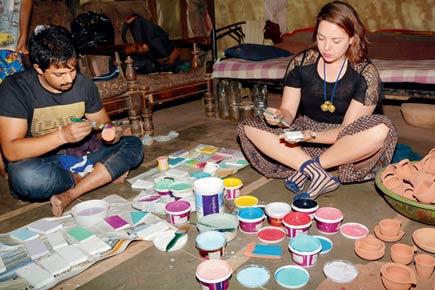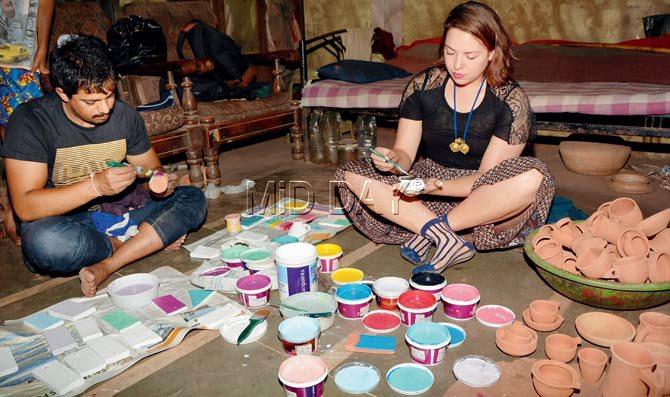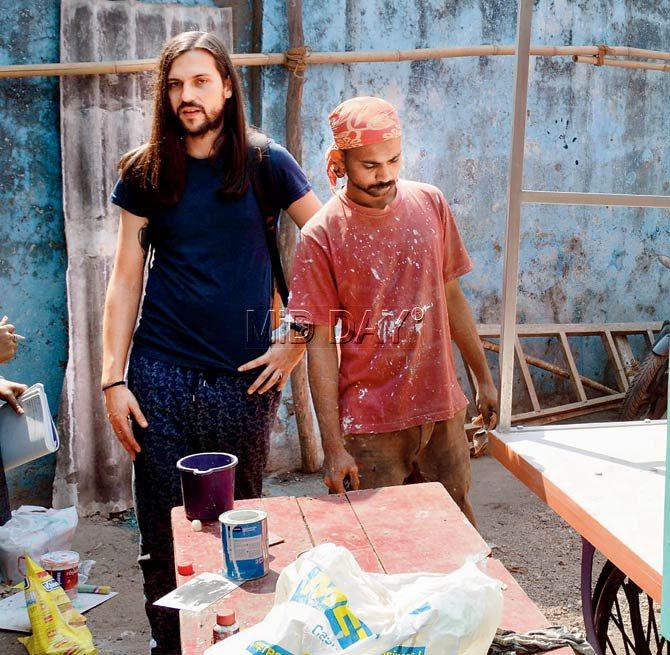A collaboration between design experts from Amsterdam and Dharavi’s residents, the design-museum-on-wheels gets ready to move into the shantytown’s lanes

Mitul Nathabhai Chauhan, a fourth generation potter, applies a coat of paint to terracotta slabs, the size of mobile phones. Beside him is a pile of assorted cups, mugs and saucers, also terracotta. “In our walks around Dharavi, we saw that drinking chai is something of a ritual,” says art historian Amanda Pinatih, co-founder of the Dharavi Design Museum. “We re-imagined the experience of drinking it. People often pour it from their cups into saucers and sip. So, we thought this beak on the saucer would help,” she says, selecting a shallow diya-shaped bowl from the pile.

Kumbharwada potter Mitul Nathabai Chauhan and art historian Amanda Pinatih prepare design-tweaked terracotta chai glasses. Pics/Sayed Sameer Abedi
ADVERTISEMENT
This nouveau chai cutlery along with the painted plaques are part of a project funded by Creative Industries Fund NL and The Art of Impact, and supported in Dharavi by urban research collective URBZ. And its first exhibition opens tomorrow at Prabuddh Sanskrutik Mandal in Matunga Labour Camp. Visual artist Jorge Mañes Rubio and Pinatih, both from Amsterdam, have been put up in Dharavi for a week, prepping to work a “design change” into the working lives of the town’s craftspeople. In the last week, they have collaborated with the broom-making Kunchi Kurve community, potters of Kumbharwada and resident carpenters to come up with products that are familiar but carry a design tweak. “Dharavi is not just about manual labour and repetition,” says Mañes Rubio, explaining the duo's purpose.

Visual artist Jorge Manes Rubio, co-founder of Design Museum Dharavi with a worker setting up the museum-on-wheels cart
Museum on wheels
“A museum is part of something bigger. Dharavi has hospitals and schools, but a museum is like a cultural cathedral. It is what all big cities have,” says Pinatih, explaining why they chose to call the intervention a ‘museum’.
However, challenging its brick-and-motor definition, the Design Museum Dharavi will be a humble utility cart. On Tuesday noon, painters and carpenters tinkered away at the 8’x4’ turquoise and salmon cart parked to the side of a ground at the end of a lane. “The supports below the cart are going to remain purple and yellow, so that the BMC doesn’t pick it up,” says Mañes Rubio. The cart looks compact, but doors of the shelf blossom into a wide 24 feet area. It is here that the chai cutlery, terracotta plaques and other design objects will be placed before it roams Dharavi.
“This is not a gift shop kind of museum; this is where things start to happen. It is on this that products that are socially relevant will be taken around Dharavi,” says Mañes Rubio.
Social design
On Monday, for instance, when they were interacting with broom-maker Sunil Kuchi Kurve and his friends, who showed them 20 broom designs. “But we wanted him to think of something new,” says Mañes Rubio.
He quickly sketched a mock-up on paper (most craftspeople in Dharavi don’t sketch but carry “designs in their minds”) and thus was borne a coconut-tree like parasol — made of bamboo and dry leaves — that will now provide shelter to the museum cart. Over at Kumbharwada, for instance, instead of the regular water pots, Chauhan has designed beer-tower like containers, which he says are more space-efficient than spherical pots.
The key, say Mañes Rubio and Pinatih, is to look at local products and design methods, and turn them around. The mehendi-like embellishments that the potters so often make on their wares will also get a rethink, as was in progress when we met Chauhan and Ashwin Narsibhai Wadher, who assists him in finishing touches. Wadher, a self-taught painter, has fashioned the many handles of cups and mugs — some triangular, some shaped like the human ear.
New takers?
“Rather than changing the product, we are looking at changing the thought process. Can you make things differently, is what we are asking” says Mañes Rubio, for whom this is a second attempt at understanding Dharavi. An earlier one, in October 2011, he describes as “frustrating”, since a breakthrough with the locals failed to occur.
Thursday’s exhibition will also be a testing ground for customer reaction. When we ask Chauhan, who exports 20,000 units of earthenware to the USA and South Africa annually, he is skeptical about the demand for new designs. “Since these take some time to make, I will obviously have to price them higher. It is not that potters don’t innovate; it all boils down to demand. If a customer doesn’t want a piece in large volumes, I won’t be making them.”
Design Museum Dharavi will enter a second phase after this initial exhibition. Cricket is on the mind of the founders, who are going to interact with makers to devise paraphernalia surrounding the game including leather gloves and new bat designs. The products will go through a cycle of natural selection, to see what fits use, and what ultimately lives on in Dharavi. Until there, there is chai and jugaad.
 Subscribe today by clicking the link and stay updated with the latest news!" Click here!
Subscribe today by clicking the link and stay updated with the latest news!" Click here!







